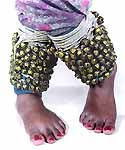Guns, Whiskey, Kungfu, and Indian Dance
/Some people might say, “Scott, you’ve been practicing martial arts so long you have gon
 gfu on the brain.” It’s a possibility, I admit. Sometimes I get excited and I start to see martial arts in everything (Richard Rorty would call it the narcissistic tendency of powerful ideas). I can use Kungfu power to scrub the dishes. I can use maximum muscle tendon twisting to wring-out the laundry. I can set the table “the way a beautiful woman would do it,” (that’s an alternate name for Baguazhang seventh palm change).
gfu on the brain.” It’s a possibility, I admit. Sometimes I get excited and I start to see martial arts in everything (Richard Rorty would call it the narcissistic tendency of powerful ideas). I can use Kungfu power to scrub the dishes. I can use maximum muscle tendon twisting to wring-out the laundry. I can set the table “the way a beautiful woman would do it,” (that’s an alternate name for Baguazhang seventh palm change).But Chitresh Das, my Kathak (North Indian Classical Dance) teacher always said that Kathak had roots in the warrior tradition. Ladies of ill repute did the same style of dance, under a different name of course, but that does not discount it’s warrior origins. All Indian Classical dance has some version of deity invocation as well. Kathak is done with 5 to 10 pounds of small bronze bells wrapped around the ankles and calves. While it makes little sense from a guerrilla warfare point of view, an assembly of several thousand warriors stamping the ground with all those bells would rival the terror inducing sounds of a line of M1 tanks. Besides, they function as armor for the lower leg and weight training. Oh, and every movement from the warrior dances of Arjuna to the blood lusts of the Goddess Kali, to the dragon-tail pulling antics of Baby Krishna, to the flower picking of Princess Rada --can all be done with martial power and embodiment. In fact, the stances and silk-reeling of Chen Style Taijiquan feel like kissing cousin’s to the Indian tradition I learned.
 I’ve had a taste of several different styles of African and African Diaspora Dances but my actual training was in Congolese and African-Haitian Dance. My Congolese Dance teacher, Malonga Casquelourd, learned to dance from soldiers on army bases. Malonga’s father was a high ranking soldier in the Congolese Army and the family followed his deployments around the country. Malonga had a fighter’s body and spirit. Both Congolese and Haitian styles of dance have specific war/fighting training in them, but even the dances for funerals (sometimes confrontational), dances for dating/mating (also prone to challenges), and dances for work--all can be seen through my martial artist lens. The embedded fighting techniques are hidden everywhere in plain sight, they only need to be practiced as fighting, with a partner, to become functional.
I’ve had a taste of several different styles of African and African Diaspora Dances but my actual training was in Congolese and African-Haitian Dance. My Congolese Dance teacher, Malonga Casquelourd, learned to dance from soldiers on army bases. Malonga’s father was a high ranking soldier in the Congolese Army and the family followed his deployments around the country. Malonga had a fighter’s body and spirit. Both Congolese and Haitian styles of dance have specific war/fighting training in them, but even the dances for funerals (sometimes confrontational), dances for dating/mating (also prone to challenges), and dances for work--all can be seen through my martial artist lens. The embedded fighting techniques are hidden everywhere in plain sight, they only need to be practiced as fighting, with a partner, to become functional.Without the Redneck contribution to American tolerance, we would, as a culture, be cut off from understanding what it is to be a man who dances. World-wide, a significant part of what it is for a man to express himself through dance is a demonstration of his ability to fight, a show of martial prowess. (And I dare say, the same is often true for women.)

